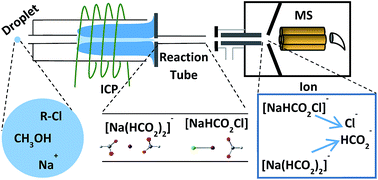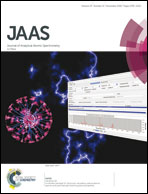Mechanistic insights into chloride ion detection from the atmospheric-pressure afterglow of an argon inductively coupled plasma†
Abstract
Elemental analysis of chlorine using inductively coupled plasma mass spectrometry (ICP-MS) is challenging because of poor ion formation efficiency of Cl+ in the argon plasma, and prevalence of isobaric interferences. To improve Cl detection, we have recently developed plasma assisted reaction chemical ionization (PARCI) in which an Ar-ICP is coupled to an atmospheric-pressure afterglow reaction tube, leading to high-sensitivity detection of Cl−. We have shown that introduction of sodium and methanol into the ICP improves Cl− sensitivity in PARCI-MS to levels better than those of conventional ICP-MS/MS. In this report, we probe the chloride ion formation mechanism in the ICP afterglow via examining the impact of the aerosol gas flow rate and torch box exhaust flow rate on Cl− detection. Specifically, we evaluate analyte breakdown in the ICP, sampling of plasma products into the afterglow reaction tube, and ion–neutral reactions in the atmospheric-pressure afterglow as major processes for chloride ion formation in PARCI. We find that aerosol carrier gas flow rates ≤ 2.2 L min−1 result in compound-independent response factors for Cl, indicating sufficient residence time in the plasma for efficient breakdown of analytes. Notably, we show that torch box exhaust flow rate has a drastic impact on Cl− sensitivity. This effect stems from its influence on plasma sampling efficiency and on ion–neutral reactions in the afterglow. Lastly, our results indicate that clusters formed in the afterglow reaction tube play critical roles in Cl− detection. Specifically, [NaClHCO2]− and [NaClNO2]− are identified as key species for Cl− detection from chlorinated compounds introduced into the ICP in conjunction with methanol and sodium. Ab initio calculations indicate thermodynamically favorable reactions for formation of these cluster ions, supporting the importance of cluster formation in the ICP afterglow for high-sensitivity chloride ion detection.



 Please wait while we load your content...
Please wait while we load your content...
